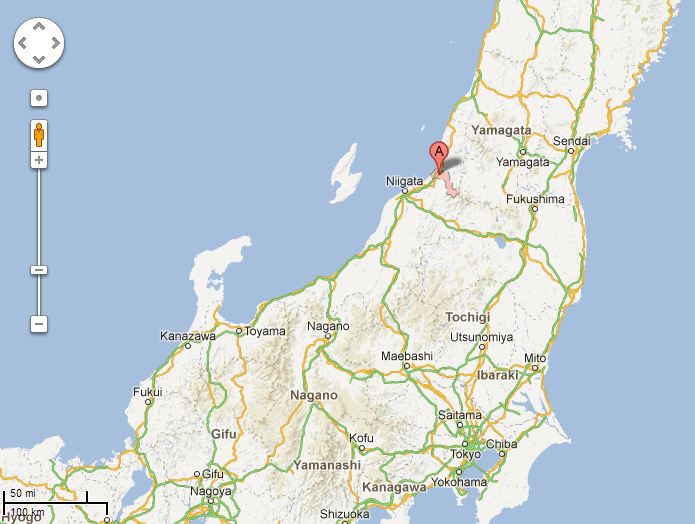“Ignore the rules and you’ll get jam in your sneakers.”
The teachers may not always know about them, but throughout schools in Japan there are a number of unwritten rules that have been passed down from school generation to school generation and must be obeyed. First graders may only use the old, “haunted” toilet block nearest to the gym; only third graders may wear their backpack with just one strap; the cute art teacher must never be gazed upon by anyone other than the boys from class 2-F…
Entering a new school and being told to obey these long-standing rules “or else”, many kids probably wonder why their seniors, or “senpais“, are such jerks. But as the years go by and they, too, slowly rise to power and reap the rewards of having aged a couple of years, few are in a hurry to abolish the “ura“, or “other side”, code of conduct.
According to a report by Japan’s Yomiuri Online, however, students at a school in Tainai City, Niigata Prefecture have taken the unusual step of openly discussing these rules and swearing to abide by them no more.
In an effort to create a more harmonious learning environment, the student council at Tainai Junior High School carried out a series of meetings and conducted surveys over the space of a year, gathering data and listening to students’ opinions regarding unfair practices and the hierarchies that exist within the school grades.
The council began by asking students whether they felt that the presence of these “ura rules” was a good or bad thing, and which rules they most disagreed with. Of 120 students surveyed, a whopping 99 kids said that they would prefer that the rules did not exist whatsoever, stating that they’d rather “enjoy a more pleasant” school environment, with many third grade students stating that they, too, had thought the rules unfair during their first two years at the school.
Not everyone agreed, however. As many as 19 students felt that, since they had suffered the same hardships, it would be wrong to abolish the student code at that point, arguing that the rules had made them the people that they are.
In a series of surveys carried out by the student council and committees staffed by teachers and education staff, a number of “ura rules” were identified and discussed openly.
Here is just a small sample of the curious codes of conduct that thousands of students have lived by, in some cases for generations:
– First and second graders (whose classroom are on the third floor) are forbidden to use the restroom located on the third graders’ (second) floor. Furthermore, first graders must go down to the first floor and use the toilets there out of consideration for the second graders with whom they share a floor.
– First-year students may not use the staircase located closest to the main entrance.
– First graders must never leave their jersey sweater unzipped during gymnastics practice.
– First graders must only use plain, dark-coloured backpacks.
– During the summer term, first and second graders must wear a vest. Second graders may unfasten their top button.
While some of the rules are startlingly detailed, articles referring to such things as the colour backpack a student may carry or the use of a simple zip betray the juvenile thinking of their creators. But the kids of Japan are growing up and have decided that enough is enough.
“I’m very happy that steps are being taken to tackle this issue and raise awareness,” said one student. “I’d like my seniors to do their best to someday make these kinds of rules disappear completely.”
Japan has struggled with issues of bullying, which have in some cases resulted in children committing suicide, for years now, and there has been call for closer monitoring of student behaviour and to create an atmospshere where students of all ages can coexist and study with minimal stress. Seeing young people like those in Niigata Prefecture – especially those who have already had these unfair ura rules imposed upon them and were most likely looking forward to becoming the top dogs – taking the initiative and actively seeking change, however, is nothing short of heart-warming and something that we hope to see much more of in the near future.
Source: Yomiuri Online
Map courtesy of Google Maps
▼ Tainai City is located in Northwest Japan


 Japanese high schools abolish old rules, provide freedom with underwear, hair and dating
Japanese high schools abolish old rules, provide freedom with underwear, hair and dating Former schoolgirl sues Tokyo high school that made her drop out for breaking no-dating rule
Former schoolgirl sues Tokyo high school that made her drop out for breaking no-dating rule Elementary and junior high students speak out on Japan’s strangest school rules
Elementary and junior high students speak out on Japan’s strangest school rules Head of Tokyo board of education gets asked about dumb school hairstyle rule, gives dumb answer
Head of Tokyo board of education gets asked about dumb school hairstyle rule, gives dumb answer Students in Finland, the world’s best-educated country, react to Japan’s harsh school rules
Students in Finland, the world’s best-educated country, react to Japan’s harsh school rules We revisited Sweets Paradise after a decade to see if Japan’s dessert buffet still delivers
We revisited Sweets Paradise after a decade to see if Japan’s dessert buffet still delivers That time Seiji called JASRAC to ask why he didn’t get paid royalties for his song being on TV
That time Seiji called JASRAC to ask why he didn’t get paid royalties for his song being on TV Cup Noodle tries an authentic Jiro-style ramen, but something’s not quite right
Cup Noodle tries an authentic Jiro-style ramen, but something’s not quite right 7 great places to see Mt. Fuji from without having to climb it
7 great places to see Mt. Fuji from without having to climb it McDonald’s Japan has free smiles on its delivery menu, but does asking for one make a difference?
McDonald’s Japan has free smiles on its delivery menu, but does asking for one make a difference? In downtown Tokyo, we talk to a guy who says he’s from Orion’s belt, get called an “idiot”
In downtown Tokyo, we talk to a guy who says he’s from Orion’s belt, get called an “idiot” Pizza Hut Japan’s hot lucky bags are perfect for a New Year’s pizza party
Pizza Hut Japan’s hot lucky bags are perfect for a New Year’s pizza party Japanese gamer furniture company creates cabinets just for collectible trading card gamers【Pics】
Japanese gamer furniture company creates cabinets just for collectible trading card gamers【Pics】 More than one in three Japanese working women in survey would rather be housewives
More than one in three Japanese working women in survey would rather be housewives Eat Kuroge Wagyu beef at this Japanese restaurant in Ginza for less than 10 bucks!
Eat Kuroge Wagyu beef at this Japanese restaurant in Ginza for less than 10 bucks! Starbucks Japan ready to get Year of the Horse started with adorable drinkware and plushies【Pics】
Starbucks Japan ready to get Year of the Horse started with adorable drinkware and plushies【Pics】 Cyberpunk anime meets traditional culture in Ghost in the Shell gold leaf Japanese changing screens
Cyberpunk anime meets traditional culture in Ghost in the Shell gold leaf Japanese changing screens Hello Kitty Choco Egg figures are an adorable trip through three periods of Japanese pop culture【Pics】
Hello Kitty Choco Egg figures are an adorable trip through three periods of Japanese pop culture【Pics】 7-Eleven Japan’s ramen-cooking robot whipped us up a bowl of noodles【Taste test】
7-Eleven Japan’s ramen-cooking robot whipped us up a bowl of noodles【Taste test】 We found possibly the quietest Japanese-style hotel in Tokyo’s bustling Shinjuku district
We found possibly the quietest Japanese-style hotel in Tokyo’s bustling Shinjuku district Japan’s otoshidama tradition of giving kids money at New Year’s gets a social welfare upgrade
Japan’s otoshidama tradition of giving kids money at New Year’s gets a social welfare upgrade Sumo Sanrio! Hello Kitty and pals team up with Japan Sumo Association for new merch【Pics】
Sumo Sanrio! Hello Kitty and pals team up with Japan Sumo Association for new merch【Pics】 More Than a Capsule Stay: Why Solo Travelers Choose “global cabin Yokohama Chinatown”
More Than a Capsule Stay: Why Solo Travelers Choose “global cabin Yokohama Chinatown” Japan’s oldest largetooth sawfish in captivity back on display in Mie Prefecture
Japan’s oldest largetooth sawfish in captivity back on display in Mie Prefecture 7-Eleven Japan starts new temporary luggage storage service in over 300 branches
7-Eleven Japan starts new temporary luggage storage service in over 300 branches Disillusionment at Tsukiji’s tourist-target prices led us to a great ramen restaurant in Tokyo
Disillusionment at Tsukiji’s tourist-target prices led us to a great ramen restaurant in Tokyo Starbucks teams up with 166-year-old Kyoto doll maker for Year of the Horse decorations【Photos】
Starbucks teams up with 166-year-old Kyoto doll maker for Year of the Horse decorations【Photos】 Tokyo considering law requiring more trash cans following litter increase in heavily touristed area
Tokyo considering law requiring more trash cans following litter increase in heavily touristed area Tokyo’s Tsukiji sushi neighborhood asks tour groups to stay away for the rest of the month
Tokyo’s Tsukiji sushi neighborhood asks tour groups to stay away for the rest of the month Tokyo event lets you travel back in time, for free, to celebrate 100 years since Showa era start
Tokyo event lets you travel back in time, for free, to celebrate 100 years since Showa era start Sanrio theme park in Japan announces plans to expand into a Sanrio resort
Sanrio theme park in Japan announces plans to expand into a Sanrio resort Japan may add Japanese language proficiency, lifestyle classes to permanent foreign resident requirements
Japan may add Japanese language proficiency, lifestyle classes to permanent foreign resident requirements Stamina-destroying “Paralysis Noodles” are Tokyo’s newest over-the-top ramen innovation
Stamina-destroying “Paralysis Noodles” are Tokyo’s newest over-the-top ramen innovation Survey asks foreign tourists what bothered them in Japan, more than half gave same answer
Survey asks foreign tourists what bothered them in Japan, more than half gave same answer Japan’s human washing machines will go on sale to general public, demos to be held in Tokyo
Japan’s human washing machines will go on sale to general public, demos to be held in Tokyo Japan’s deadliest food claims more victims, but why do people keep eating it for New Year’s?
Japan’s deadliest food claims more victims, but why do people keep eating it for New Year’s? We deeply regret going into this tunnel on our walk in the mountains of Japan
We deeply regret going into this tunnel on our walk in the mountains of Japan Studio Ghibli releases Kodama forest spirits from Princess Mononoke to light up your home
Studio Ghibli releases Kodama forest spirits from Princess Mononoke to light up your home Major Japanese hotel chain says reservations via overseas booking sites may not be valid
Major Japanese hotel chain says reservations via overseas booking sites may not be valid Put sesame oil in your coffee? Japanese maker says it’s the best way to start your day【Taste test】
Put sesame oil in your coffee? Japanese maker says it’s the best way to start your day【Taste test】 No more using real katana for tourism activities, Japan’s National Police Agency says
No more using real katana for tourism activities, Japan’s National Police Agency says Starbucks Japan reveals new sakura drinkware collection, inspired by evening cherry blossoms
Starbucks Japan reveals new sakura drinkware collection, inspired by evening cherry blossoms Updated cherry blossom forecast shows extra-long sakura season for Japan this year
Updated cherry blossom forecast shows extra-long sakura season for Japan this year All Tokyo public high schools abolish rules forcing students to dye non-black hair, underwear color regs
All Tokyo public high schools abolish rules forcing students to dye non-black hair, underwear color regs This six-year-old Japanese girl is school’s one and only first-grader as lack-of-kids shutdown ends
This six-year-old Japanese girl is school’s one and only first-grader as lack-of-kids shutdown ends “Students are only allowed three sneezes in class” Japanese people share their worst school rules
“Students are only allowed three sneezes in class” Japanese people share their worst school rules Japanese schoolgirl points out an especially dumb part of her school’s “no tights” dress code
Japanese schoolgirl points out an especially dumb part of her school’s “no tights” dress code Cha-Ching! Kids in Japan Receive Up to $1,500 During New Year’s
Cha-Ching! Kids in Japan Receive Up to $1,500 During New Year’s Why do kids in Japan use those large leathery “randoseru” school bags?
Why do kids in Japan use those large leathery “randoseru” school bags? Teacher says Japanese schools’ mandatory extracurricular activity rules don’t benefit students
Teacher says Japanese schools’ mandatory extracurricular activity rules don’t benefit students Japanese public school to allow male students to wear skirts, chest ribbons as part of uniform
Japanese public school to allow male students to wear skirts, chest ribbons as part of uniform Japanese junior high school girl removed for class from three days for grooming her eyebrows
Japanese junior high school girl removed for class from three days for grooming her eyebrows Illustration by manga artist shows why elementary kids should be allowed to leave books at school
Illustration by manga artist shows why elementary kids should be allowed to leave books at school Some Japanese school regulations don’t make any sense!
Some Japanese school regulations don’t make any sense! Japanese middle school criticized for pulling out girls’ bra straps to check their color
Japanese middle school criticized for pulling out girls’ bra straps to check their color Some Japanese elementary schools don’t let kids wear underwear during P.E., and parents are mad
Some Japanese elementary schools don’t let kids wear underwear during P.E., and parents are mad Checking in on randoseru school bags and the changing tastes of Japanese kids
Checking in on randoseru school bags and the changing tastes of Japanese kids Japanese schools banning nicknames, mandating use of -san divides opinions
Japanese schools banning nicknames, mandating use of -san divides opinions
Leave a Reply